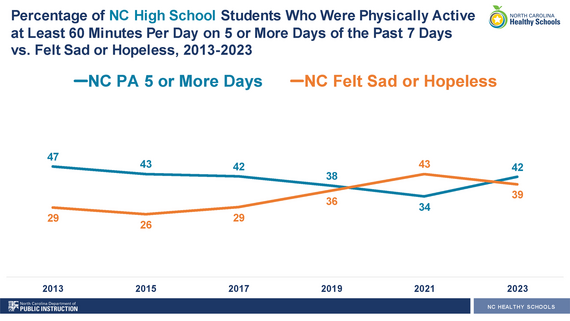|
North Carolina students’ mental health is improving as they become more physically active, according to the results of the 2023 NC Youth Risk Behavior Surveys (YRBS) presented to the State Board of Education today.
After nearly a decade of declining physical activity and mental health metrics, the new data shows positive trends in both categories.
The percentage of high school students who reported feeling sad or hopeless dropped to 39 percent for 2023 after reaching 43 percent in 2021. The percentage of middle school students feeling sad or hopeless dropped from 35 to 32 percent during the same time period.
Several other metrics related to students’ feelings about themselves and their teachers also improved. The percentage of high school students who seriously considered suicide in the past year dropped from 22 percent in 2021 to 18 percent in 2023.
Meanwhile, 42 percent of high school students said they were physically active for at least 60 minutes on five or more days a week, an increase from 34 percent in 2021. Among middle school students, 52 percent said they were physically active for at least 60 minutes on five or more days a week, up from 44 percent in 2021.
 The NC Middle School Youth Risk Behavior Survey and the NC High School Youth Risk Behavior Survey are administered to representative samples of randomly selected students on odd numbered years. They are anonymous and parents may opt their child out of participating.
The agency chooses questions for the surveys from a list created by the Centers for Disease Control & Prevention that is used by education agencies and schools across the nation.
In recognition of the growing role of technology in students’ lives, this year’s surveys included questions on social media for the first time.
More than 80 percent of high schoolers report using social media at least several times a day, and about half of those students say they use it at least once an hour. Middle schoolers access social media a little less, with 63 percent using it at least several times a day.
The use of vape products, marijuana and alcohol are also on the decline for high school students. Cigarette smoking is stagnant at an all-time low of 4 percent. There has been no significant change in prescription painkiller use or bullying.
The 2023 data shows a marked improvement from the 2021 surveys, which were the first after the COVID-19 pandemic.
“It is so encouraging to see that students are not only recovering from the effects of the pandemic, but in many cases doing better than they were in 2019 and before,” said Deputy State Superintendent Michael Maher, who oversees standards, accountability and research.
Ellen Essick, section chief for NC Healthy Schools, said the positive effect of exercise on mental health is well documented. An amendment to the existing Healthy Active Children Policy was brought to the board for consideration that would expand on existing language that calls for 30 minutes per day of physical activity per day students in kindergarten through eighth grade. The proposed revisions would encourage high schools to offer students 60 minutes per week of physical activity.
"We’ve heard over and over from school leaders that student mental health is a top priority for them, and it’s a top priority for us at NCDPI, too. Based on the YRBS data and national research, we believe this addition to the Healthy Active Children Policy will make a positive impact,” Essick said. “Students can’t reach their full potential in the classroom if they are not mentally and physically well. Giving them more access to exercise during the school day should ultimately result in better academic outcomes.”
Board members discussed the policy today and will vote on it at their July meeting.
|